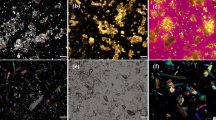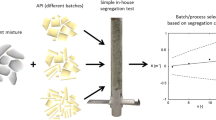Abstract
Obtaining a homogeneous low-dose pharmaceutical powder blend without multi-step processing remains a challenge. One promising technology to address this risk is resonant acoustic mixing (RAM). In this study, the performance of a laboratory resonant acoustic mixer (LabRAM) was studied at low active pharmaceutical ingredient (API) concentrations (0.1–0.5% w/w), using three commercial grades of a model API (Acetaminophen) and diluents with varying physical properties. The performance was assessed by evaluating blend uniformity (BU) and capsule content uniformity (CU) as a function of mixing time. Overall, the LabRAM achieved acceptable BU in a single step even at 0.1% w/w drug loading. A reduction in API primary particle size led to improved mixing efficiency and uniformity. Moreover, the presence of surface cavities in the diluents used appeared to have led to improved uniformity. The results demonstrated that RAM could achieve uniform powder blends without multi-step processing, for low-dose formulations.
Graphical Abstract








Similar content being viewed by others
References
Zheng J, editor. Formulation and analytical development for low-dose oral drug products. Wiley; 2009.
Deveswaran R, Bharath S, Basavaraj BV, Abraham S, Furtado S, Madhavan V. Concepts and techniques of pharmaceutical powder mixing process: a current update. Res J Pharm Technol. 2009;2(2):245–9.
Paul EL, Atiemo-Obeng VA, Kresta SM, editors. Handbook of industrial mixing: science and practice. Wiley; 2003.
Muzzio FJ, Alexander A, Goodridge C, Shen E, Shinbrot T, Manjunath K, Dhodapkar S, Jacob K. Solids mixing. Handbook of industrial mixing. 2004:887-985.
Figueroa I, Li H, McCarthy J. Predicting the impact of adhesive forces on particle mixing and segregation. Powder Technol. 2009;195(3):203–12.
Chaudhuri B, Mehrotra A, Muzzio FJ, Tomassone MS. Cohesive effects in powder mixing in a tumbling blender. Powder Technol. 2006;165(2):105–14.
US Food and Drug Administration. CFR-code of federal regulations title 21.
Massol-Chaudeur S, Berthiaux H, Dodds JA. Experimental study of the mixing kinetics of binary pharmaceutical powder mixtures in a laboratory hoop mixer. Chem Eng Sci. 2002;57(19):4053–65.
Lemieux M, Bertrand F, Chaouki J, Gosselin P. Comparative study of the mixing of free-flowing particles in a V-blender and a bin-blender. Chem Eng Sci. 2007;62(6):1783–802.
Perrault M, Bertrand F, Chaouki J. An investigation of magnesium stearate mixing in a V-blender through gamma-ray detection. Powder Technol. 2010;200(3):234–45.
Alexander A, Muzzio FJ, Shinbrot T. Segregation patterns in V-blenders. Chem Eng Sci. 2003;58(2):487–96.
Brone D, Wightman C, Connor K, Alexander A, Muzzioa FJ, Robinson P. Using flow perturbations to enhance mixing of dry powders in V-blenders. Powder Technol. 1997;91(3):165–72.
Alexander A, Shinbrot T, Johnson B, Muzzio FJ. V-blender segregation patterns for free-flowing materials: effects of blender capacity and fill level. Int J Pharm. 2004;269(1):19–28.
Mehrotra A, Muzzio FJ. Comparing mixing performance of uniaxial and biaxial bin blenders. Powder Technol. 2009;196(1):1–7.
Sudah OS, Coffin-Beach D, Muzzio FJ. Quantitative characterization of mixing of free-flowing granular material in tote (bin)-blenders. Powder Technol. 2002;126(2):191–200.
Arratia PE, Duong NH, Muzzio FJ, Godbole P, Lange A, Reynolds S. Characterizing mixing and lubrication in the Bohle Bin blender. Powder Technol. 2006;161(3):202–8.
Kaye BH. Powder mixing, vol. 10. Springer Science & Business Media; 1997.
Mixing & Blending. Available from: https://www.powderbulksolids.com/mixers-blenders/mixing-blending-3. Accessed 05 Oct 2020.
The science behind the mixing zone. Available from: https://www.powderbulksolids.com/mixers-blenders/science-behind-mixing-zone. Accessed 26 Jan 2021.
Mahmoudi ZN, Do N, Farrell TP, Rajabi-siahboomi AR. Influence of filler type in the blend uniformity of micronized drugs. 2019;2019:19438.
Starch 1500 ® Application data assessment of low dose content uniformity of indomethacin in excipient blends using FT-Raman map** spectroscopy.
Ahmed H, Shah N. Formulation of low dose medicines - theory and practice. Am Pharm Rev. 2000;3(3):1–5.
Osorio JG, Muzzio FJ. Evaluation of resonant acoustic mixing performance. Powder Technol. 2015;278:46–56.
Osorio JG, Hernández E, Romañach RJ, Muzzio FJ. Characterization of resonant acoustic mixing using near-infrared chemical imaging. Powder Technol. 2016 Sep;1(297):349–56.
Resodyn Technical Library - Resodyn Acoustic Mixers. Available from: https://resodynmixers.com/technical-library/. Accessed 03 Oct 2020.
Coguill S, Farrar L. Mixers RA. InInternational Pyrotechnics Seminar: Resonant acoustic mixing of PBX; 2014.
Tanaka R, Takahashi N, Nakamura Y, Hattori Y, Ashizawa K, Otsuka M. Verification of the mixing processes of the active pharmaceutical ingredient, excipient and lubricant in a pharmaceutical formulation using a resonant acoustic mixing technology. RSC Adv. 2016;6(90):87049–57.
Applying Dry Powder Coatings | Pharmaceutical Technology. Available from: https://www.pharmtech.com/view/applying-dry-powder-coatings. Accessed 06 Oct 2020.
Goldstein JI, Newbury DE, Michael JR, Ritchie NW, Scott JH, Joy DC. Scanning electron microscopy and X-ray microanalysis. Springer; 2017 Nov 17.
Hare C, Zafar U, Ghadiri M, Freeman T, Clayton J, Murtagh MJ. Analysis of the dynamics of the FT4 powder rheometer. Powder Technol. 2015 Nov;1(285):123–7.
Jenike AW. Storage and flow of solids:(REV. 1980.). BULLETIN OF THE UTAH ENGINEERING EXPERIMENT. 1980(123).
Schulze D. Powders and bulk solids. Behaviour, characterization, storage and flow. Springer. 2008;22.
Wang Y, Osorio JG, Li T, Muzzio FJ. Controlled shear system and resonant acoustic mixing: effects on lubrication and flow properties of pharmaceutical blends. Powder Technol. 2017;322:332–9.
Guidance for industry powder blends and finished dosage units-stratified in-process dosage unit sampling and assessment draft guidance. Available from: http://www.fda.gov/cder/guidance/index.htm. Accessed 04 Oct 2020.
Domike RD, Cooney CL. Particles and blending. Pharm Blend Mixing. 2015;11:81.
Muzzio FJ, Shinbrot T, Glasser BJ. Powder technology in the pharmaceutical industry: the need to catch up fast. Powder Technol. 2002;124(1-2):1–7.
Ottino JM, Khakhar DV. Mixing and segregation of granular materials. Annu Rev Fluid Mech. 2000 Jan;32(1):55–91.
Llusa M, Sturm K, Sudah O, Stamato H, Goldfarb DJ, Ramachandruni H, Hammond S, Smith MR, Muzzio FJ. Effect of high shear blending protocols and blender parameters on the degree of API agglomeration in solid formulations. Ind Eng Chem Res. 2009;48(1):93–101.
De Villiers MM. Description of the kinetics of the deagglomeration of drug particle agglomerates during powder mixing. Int J Pharm. 1997;151(1):1–6.
Yalkowsky SH, Bolton S. Particle size and content uniformity. Pharm Res An Off J Am Assoc Pharm Sci. 1990;7(9):962–6.
Huang CY, Ku MS. Prediction of drug particle size and content uniformity in low-dose solid dosage forms. Int J Pharm. 2010;383(1-2):70–80.
Alyami H, Dahmash E, Bowen J, Mohammed AR. An investigation into the effects of excipient particle size, blending techniques & processing parameters on the homogeneity & content uniformity of a blend containing low-dose model drug. PLoS One. 2017;12(6):1–19.
Acknowledgements
The authors would like to thank Jason Sweeney, Daozhong Zou, Kalyan Vasudevan, Uday Jain, Yuchuan Gong, Anjali Agrawal, Ho-Wah Hui, Shyam Karki, and Bill Bowen from BMS, Drug Product Development for their valuable discussion and supporting this work as a part of Shashwat’s summer internship.
Funding
This research did not receive any specific grant from funding agencies in the public, commercial, or not-for-profit sectors.
Author information
Authors and Affiliations
Contributions
Shashwat Gupta: investigation, methodology, data curation, formal analysis, visualization, writing — original draft. Yu (Elaine) Pu: methodology, visualization, resources, writing — review and editing. Minglu Li: investigation; methodology. Zhengmao Li: methodology; Juan G. Osorio: conceptualization; funding acquisition; project administration; resources; formal analysis; supervision; writing — review and editing.
Corresponding author
Ethics declarations
Conflict of Interest
The authors declare that they have no known competing financial interests or personal relationships that could have appeared to influence the work reported in this paper.
Additional information
Publisher’s Note
Springer Nature remains neutral with regard to jurisdictional claims in published maps and institutional affiliations.
Rights and permissions
About this article
Cite this article
Gupta, S., Pu, Y., Li, M. et al. Assessment of Resonant Acoustic Mixing for Low-Dose Pharmaceutical Powder Blends. AAPS PharmSciTech 23, 126 (2022). https://doi.org/10.1208/s12249-022-02262-4
Received:
Accepted:
Published:
DOI: https://doi.org/10.1208/s12249-022-02262-4




